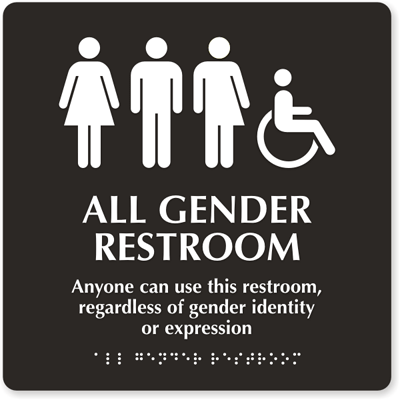You have no items in your cart. Want to get some nice things?
Go shopping
Strolling around the crowded new Whitney Museum in New York, you might walk into a particularly unexpected piece. It’s located on the gallery’s side, and most of the time no one is standing in front of it. It’s not even an artwork, but it has something very important to say about today’s America. It’s a toilet: more precisely, an all gender restroom.
Toilets have played an emblematic role in the struggle for equal rights. Race equality (Americans still remember the times when toilets where segregated), accessibility for people with disabilities, gender equality. The introduction of female restrooms in workspaces that were traditionally considered “men only”, like construction sites, meant more than just an extra toilet available. A toilet can become the acknowledgment and legitimization of a presence, and at times – like these – of an identity.
The granting of the right to feel safe and comfortable while responding to a natural need. “One of the biggest battlefields upon which the fight for transgender rights is taking place daily are restrooms”, is what people can read on REFUGE Restroom an app, that aims to provide safe restroom access for transgender, intersex, and gender nonconforming individuals.
The app, born to replace the older website Safe2Pee, maps all gender toilets in some of the biggest cities around the United States. They can be searched based on proximity to a location, rated and commented upon by the users. “It seems that every other week a transgender child is made the centre of a national news story because they used the restroom assigned to the gender they identify with”, they add. “Obviously, we believe that every transgender person should have the right to use the restroom they want to.
However, we also realize that, despite legislative victories in recent years regarding restroom usage, many transgender individuals still face both verbal and physical harassment simply for using the restroom. Nobody should have to face that”. This is why toilets remain a hot topic among lawmakers and advocates for equal rights. Last April, after weeks of political debate, Florida flushed a controversial bill, the so dubbed “Bathroom Bill,” that would have made it illegal for transgenders to use single sex restrooms that don’t match with their biological gender. A few weeks before, a Kentucky high school, the Atherton High School in Louisville, triggered protests of parents and Republican state lawmakers by allowing the students to use bathrooms and other sex segregated school facilities based on their gender identity rather than on their birth certificate. And last June, just before the historical US Supreme Court sentence that put down same sex marriage bans across the entire country, Washington made its position clear on all gender restroom matters. The Federal Government ensured equal access for transgender workers since 2011. But it is now advising other businesses and employees to do the same. A federal agency, the Occupational Safety and Health Administration, published a sort of “Best Practice”, a four page “Guide to Restroom Access for Transgender Workers”: the last push of a broader plan the Obama administration is working on to protect lesbian, gay, bisexual and transgender Americans. (It is not by chance that the White House has opened its first gender-neutral restroom.)
“There’s nothing like going into a public space and having a crisis over where you are going to use the restroom, or weather you are going to walk in and people are going to react to you being in that space negatively”, Danielle Linzer, Director of access and community programs of the Whitney Museum of American Art said to Litro, in a recent interview- whilst standing in front of a bright painting by Giorgia O’ Keeffe.
She has been working at the Whitney for six and half years, and for the museum’s new Renzo Piano-designed home on the Hudson River (opened on May 1, 2015), she has made permanent the – initial temporary initiative of all gender toilets at the Museum. “The first time we experimented with this was during the 2014 Whitney Biennial: a number of the artists were trans and wanted to have all gender restroom spaces, they wanted access to gender neutral facilities, so we started the transition of some of our pre-existing men and women restrooms to all gender spaces”, explained Danielle.
The new location, in the Meatpacking District, at the edge of Chelsea, also helped make the transition. “This area has been very significant for the LGTBQ community in New York City and in the world”, she said, referring for example to the legendary Stonewall Inn, considered the birthplace of the gay rights movement, just a few blocks away from the museum.
The Whitney is not the first New York art space to make restrooms more accessible to all genders. MoMA PS1, to take one, makes no differences: one bathroom for any kind of user. “We are making it a more visible through the application of signage to those spaces and using the language to communicate that those are all gender spaces, but we are not the first”, underlined Danielle. “Our inclusion of all gender restroom at the Whitney is just a long part of a very long history of making human facilities more accessible”, she added. “We are not just a binary society, with male and female, but there a lot of people who identify all along the spectrum”.

About Francesca Berardi
Francesca Berardi is a journalist based in New York. Since September 2011 she has been covering international politics and culture for the Italian newsgroup 24 Ore.




